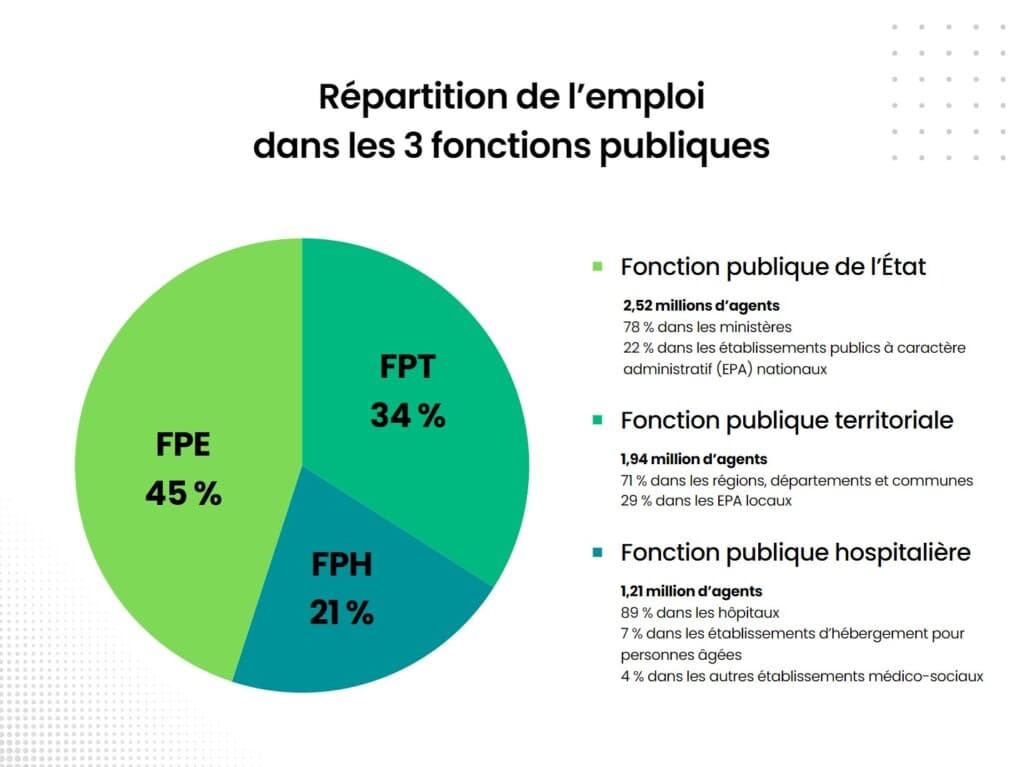[Interview]
The civil service suffers from a lack of attractiveness. In addition to recruitment difficulties, it is struggling to retain staff. "Many managers are leaving", even Caroline Brethenoux, a management trainer for the three public services, points out. For her, restoring the attractiveness of the public sector requires a necessary managerial transformation. But where do we start? What are the expectations of staff and managers? What tools and methods can be used to rekindle employee commitment? Here's what he has to say.

What are the reasons for the public service's lack of appeal? Does management contribute to this?
One young person in two has never worked in the civil service and has no plans to do so. Of these, 20 % have a poor image of the civil service. These are worrying figures, which were echoed by the Conseil d'orientation des politiques de ressources humaines last year. We can therefore sense a changes in the expectations of public servants, particularly younger ones. There may be complaints about management. But the reasons for this dislike are varied, reflecting the variety of jobs in the civil service.
Key figures
In France, almost one job in five is a public job.
At the end of 2021, 5.67 million public employees can be broken down into :
- State civil service (FPE)
- the territorial civil service (FPT)
- hospital civil service (FPH)

The civil service employs nearly 3.8 million civil servantsThere are around 1.2 million contract staff, some 300,000 military personnel and 360,000 staff in 'other categories and statuses'.
Of these staff, 38 % are in hierarchical category A (including 2 % in A+), 20 % from category B and 42 % in category C.
Source: Key figures 2023, DGAFP.
Firstly, the competition logic which gives access to civil servant status and therefore to a guaranteed job for life is no longer popular.
Many people are recruited to head of mission or project manager posts. However, these staff no longer sit competitive examinations: they leave at the end of their contract.
There is also a kind of perverse effect. In order to progress, you often have to accept geographical mobility. If there are no vacancies in their local authority, civil servants do not take part in competitions to move up the career ladder. In this case, staying in the civil service means being downgraded.
Recruitment difficulties and premature departures can also be explained by the arduous nature of certain professions. Not to mention the thorny issue of low payThis is exacerbated by part-time working.
Careers that no longer inspire dreams
Firefighters, gendarmes, nurses... These professions are no longer the stuff of dreams. We need to make them meaningful again. This involves employer branding, but also local management.
There are high drop-out rates in the gendarmerie and fire brigade schools. Many town halls fear the closure of fire stations: there is a shortage of professional firefighters.
As far as the hospital civil service is concerned, we're obviously thinking about staff turnover in hospitals. As for the lack of attractiveness, this figure speaks for itself: 30 % of qualified nurses are not practising nursing!
On the whole, we have to do the same thing with fewer resources. Or even do more, in other words, be more responsive, because citizens are more demanding than ever before. It's in the air now...
What are the levers for action to restore attractiveness? What is the role of management?
We'll have to give new meaning to the concepts of public service and general interest which are strong values. With the employer brandThe public sector can show how everyone contributes and send out a strong message that "all jobs are important". But employer branding can only be meaningful if HR policy is rethought and action is taken to improve the way people work. quality of life at work.
Act in 6 directions:
- Improve pay
- Improving working conditions
- Strengthen dialogue
- Giving meaning back to work: moving from how to why
- Encouraging career development
- Turn to more professional training
But the first step is to modernise management methods.
And to do so as close to the ground as possible. So it's up to category B managers, i.e. local managers, to restore meaning, starting with their own teams. This is a role And that often requires training. Management in the public sector has its own particularities.
What are the specific characteristics of management in the public sector?
Firstly, there is lifetime employment, which has a major impact on the management culture in the civil service.
Then, slowness. The public sector is less agile.
And above all, the resistance to change than in the private sector. It's a culture shock. In practical terms, imagine a gardener who has been asked for 20 years to mow the grass short. Now he's been told to leave the grass high (ecology, biodiversity...). The same scenario applies to the school canteen, with the introduction of a weekly vegetarian menu... So, to put it simply: employees need support as their jobs changeThese are often linked to changes in society. This needs to happen as close to the ground as possible with the team manager. But they themselves may also need support.
Faced with these particularities, the only way to transform management is by continuous improvement approach. In fact, this is the impetus given by the State with the "Fonction publique +" programme. This programme stems from the major consultation carried out in the summer of 2023 with civil servants. More than 110,253 civil servants took the opportunity to express their views (1 in 3 were in category B). One of the 6 commitments of this programme is to "develop managerial practices in order to build a relationship of trust and responsibility and to give meaning back to the tasks of civil servants".
What do employees expect most from management?
In the territorial civil service, for example, we are looking for more cross-functionality. With other local authorities. And with users.
Overall, agents want work more in project mode. They aspire to teleworking. They also expect managers to make an effort to communicate. In particular, this involves giving visibility to the projects carried out by the teams, highlighting the successes of a department, and even individual successes. In other words, managers need to provide marks of recognition and above all make it widely known.
Finally, they are faced with an additional difficulty: the vacant manager positions. For example, in a departmental council, we sometimes have 7 to 9 months of vacancies for A and A+ managerial posts. This is very common for positions in public finance. People come and go fairly quickly. It's not very motivating for the teams.
And what are the concerns of managers?
One of the main concerns for managers is reporting. How can they monitor their staff's work when they, or their staff themselves, are at risk? teleworking two or three days a week? How can we prevent teams from feeling "flipped"? If need be, how can they be punished?
Indeed, quantifying and tracing was not part of the public sector culture. Today, we need to rationalise. To put it simply: what was important before was to do a good job. What's important now is to do it on time, or even urgently. It is therefore becoming imperative for managers to know how to set priorities. In this new context, meetings must also be shorter. The focus is on efficiency. For example, a summary record of decisions will be preferred to an exhaustive 15-page report.
Second issue: how to support new arrivals? New staff often do not benefit from teleworking for the first 6 months. The manager is present two days a week and the rest of the department is virtually empty on Mondays, Wednesdays and Fridays.
Third issue: adopt the manager's posture. Although they are sometimes criticised for a lack of managerial courage, they are above all lacking in training. It's not easy to go from colleague to boss.
What are the tools, methods and best practices for transforming management?
To move towards a sustainable and operational change in practices, managers must first of all moving from a logic of means to a logic of results. To do this, they must:
- introduce more effective management and assessment tools;
- developing visual management ;
- become acculturated to data (data quality, means/results, expectations/impacts).
Next, they will benefit from manage in a more horizontal mode, favoring the project mode. They will also have to adapt their management to hybrid mode. To do this, it will be essential to take charge of the collaborative work tools. In this respect, Teams is the unanimous choice. As is Trello for project management. There are no constraints on the choice of tools, but as a result there is little harmonisation. The proliferation of tools can pose problems for long-serving staff. Hence the need for training.
Another option is to move towards cooperative management. This involves in particular:
- reviewing the essentials (meetings, conflict management, communication, delegation, etc.)
- a more individual 'micro' relationship
- the use of collective intelligence methods
- exchanges between peers (co-development)
- feedback
- coaching
- inclusion of all stakeholders (design thinking, Hackaton)
- benevolent management
Finally, the institution itself or the various levels of the hierarchy must giving legitimacy back to local managers. Firstly, this means providing them with better support, as they sometimes receive contradictory instructions. It also means providing them with better training to enable them to assert themselves as managers.
Several training priorities for category B managers :
- monitoring and planning tools
- managerial posture and assertiveness
- interpersonal communication
- cross-functional communication
How do agents and managers respond to training?
With a high staff turnover, new agents are no longer trained on the job by their colleagues. This tradition of transmission, essentially oral, is a thing of the past.
Today, tutoring and mentoring could help to restore this transmission dynamic, which is essential for cohesion. We could even consider using reverse mentoring New agents train their predecessors.
The increasing technical nature of jobs, especially in the local civil service, means that we need to strengthen the skills of our staff. training in digital developments. The situation varies between organisations that are at the cutting edge, already acculturated to digital technology or even AI, and those that are lagging behind. For example, there is a difference between the State civil service and the regional civil service. Similarly, a gulf has opened up between large cities and small towns.
The good news, however, is that all our staff have welcomed the training on offer.
Today, everyone gets training: from category C to category A
Ideally, you should have a proactive policy with a genuine management training plan. This is most often the case in large organisations that have an extensive HR department, or even a training department.
Outside this framework, and when the request for training is an employee's initiative, the manager should provide a better framework and even identify the essential training courses. As it were, the manager to define training priorities for the employeeIt is up to the employee to choose his or her training within this perimeter.
The ideal rhythm? Training at least once a year.
Furthermore, the agents are waiting for a diversification of training methods.
Especially :
- on-the-job training
- serious games
So it's no longer a question of spending x number of training days, 7 hours a day, sitting behind a table. Agents want to take an active role in training. They are also looking for something more fun.
To conclude, I would say that the managerial transformation and the training effort should enable the civil service to face up to the new challenges: ecology, artificial intelligence, IS security and attracting 'digital' profiles beyond the Ministry of Defence.





